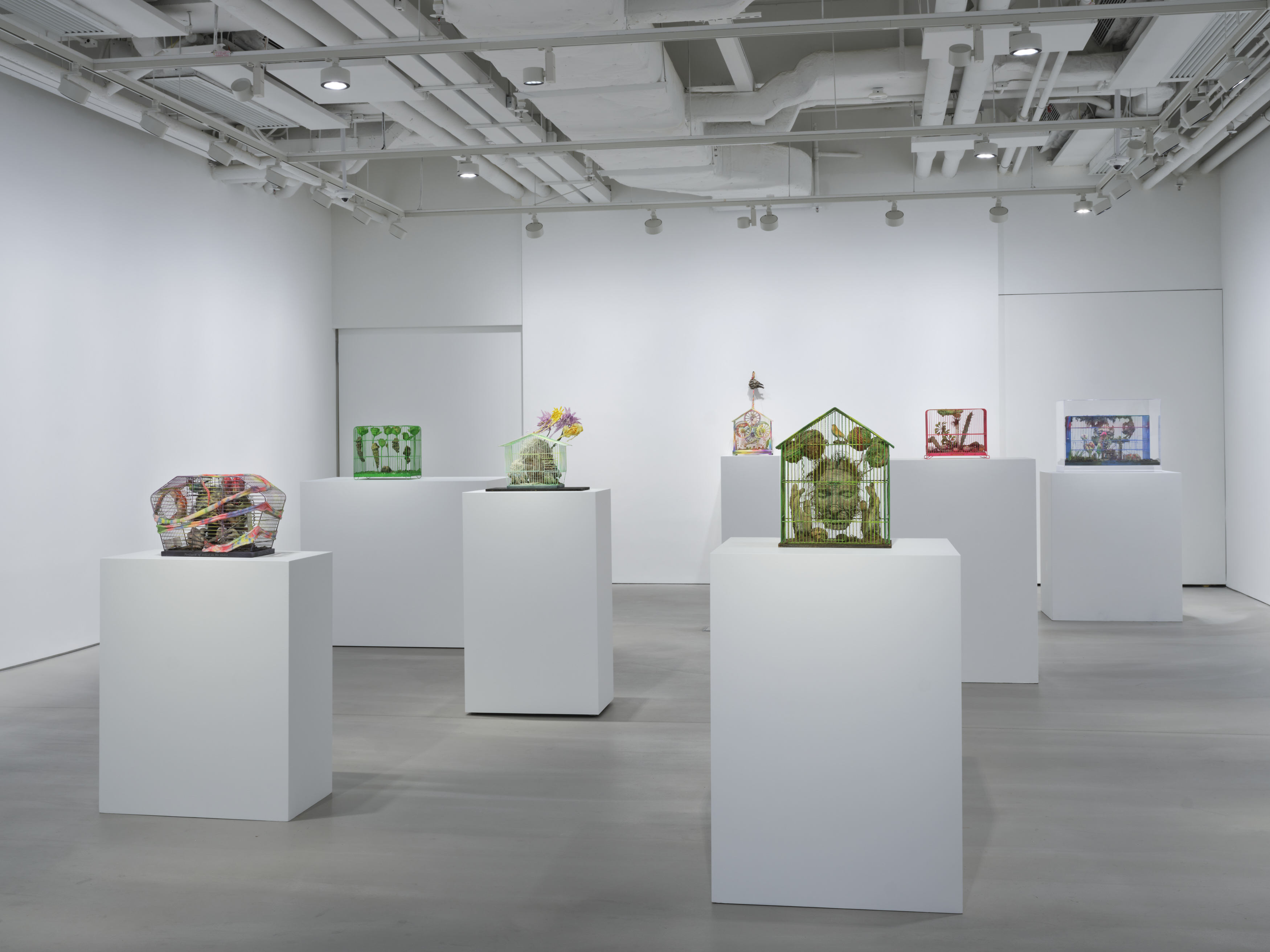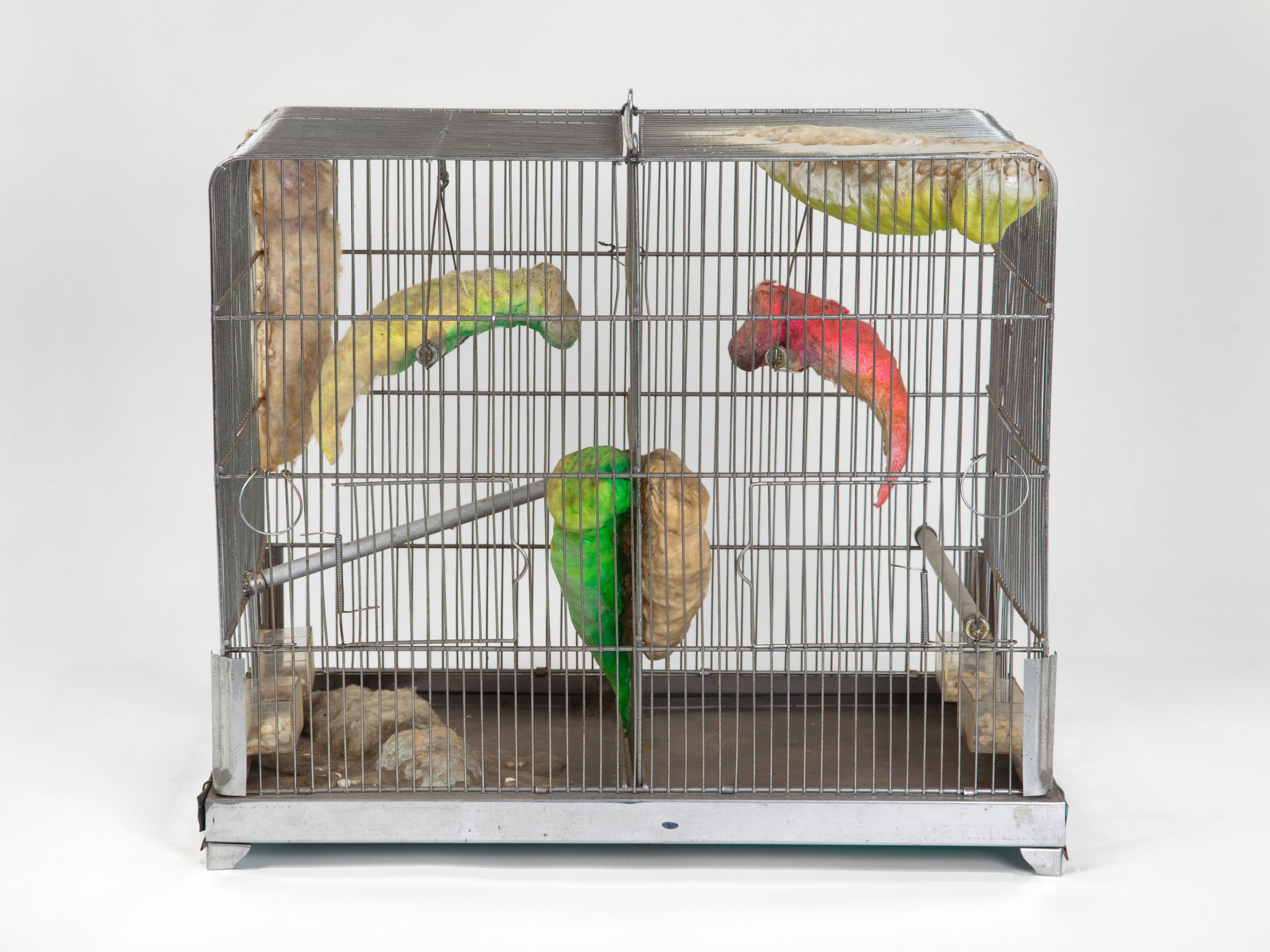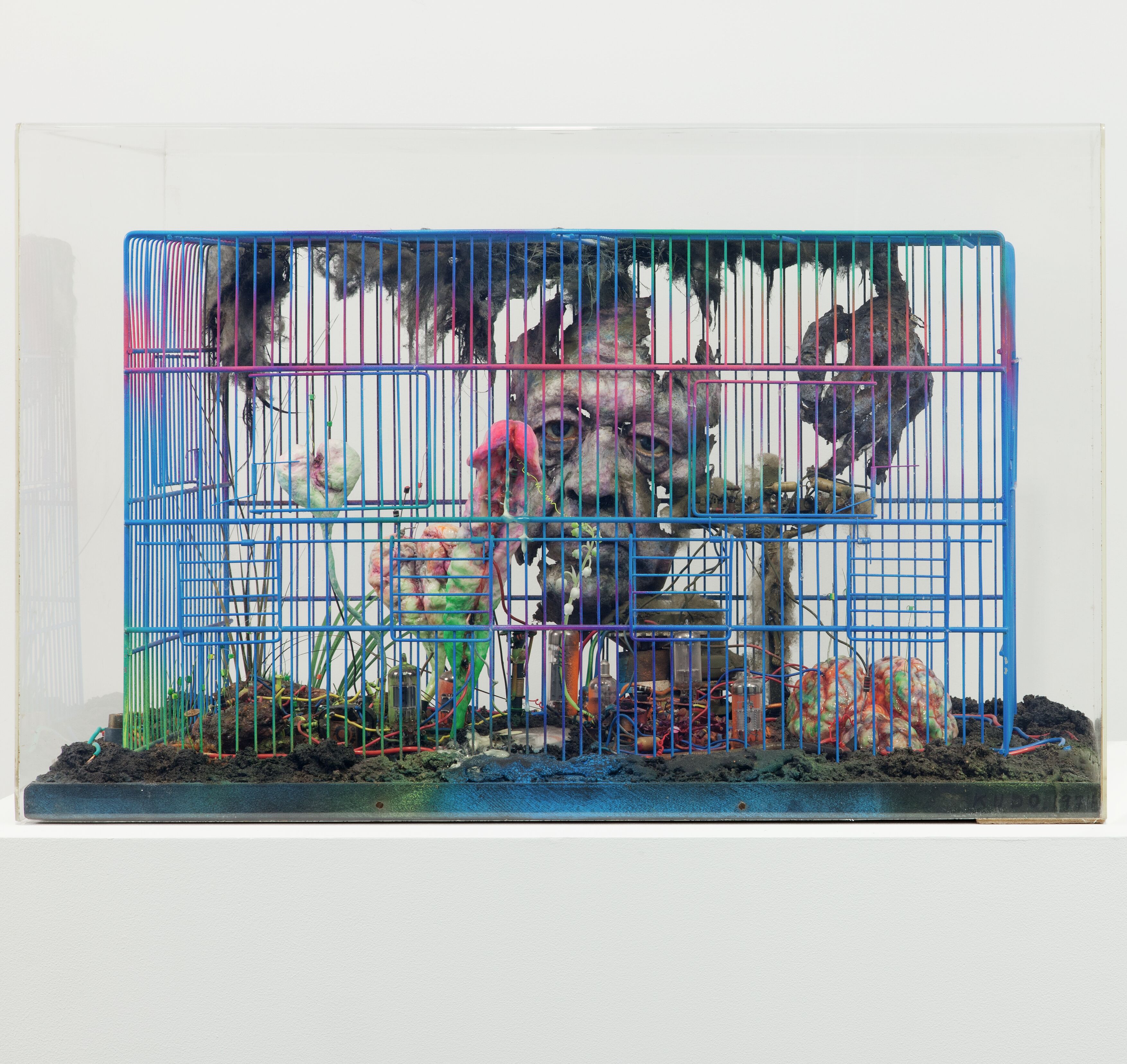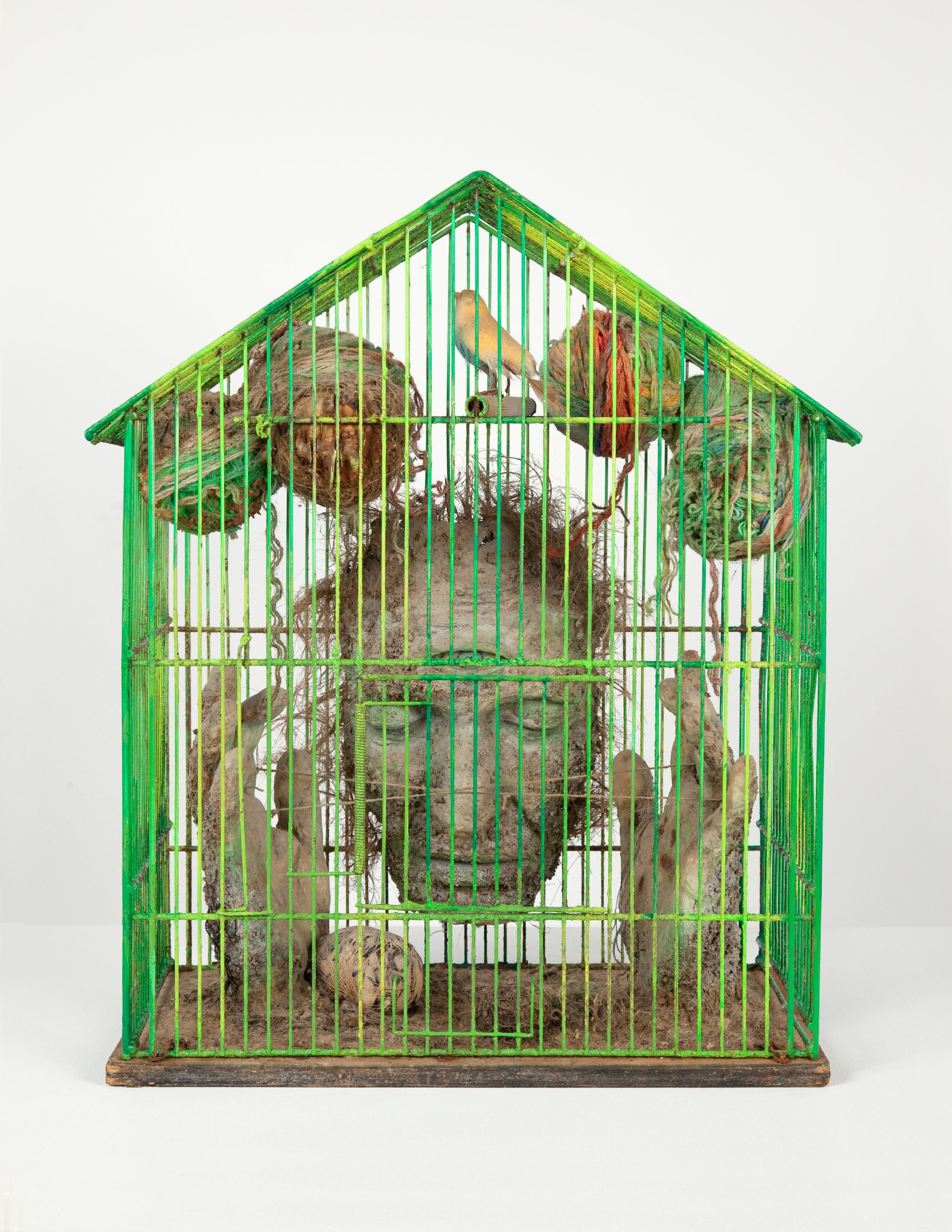Tetsumi Kudo’s “Cages”
By Camilla Alvarez-Chow

Installation view of "Tetsumi Kudo: Cages" at Hauser and Wirth, Hong Kong.
Tetsumi Kudo
Cages
Hauser & Wirth
Hong Kong
May 31–Aug 31
In Aldous Huxley’s science-fiction satire Brave New World (1932), the British novelist presents a futuristic utopia where “most men and women will grow up to love their servitude and will never dream of revolution.” Huxley asks: is sacrificing freedom worth the price of contentment? For the late Japanese avant-garde artist Tetsumi Kudo (1935–1990), humanity answered that question through its unabated desire for technological progress, a large contributor to our own species’ decay. Contemporary life, then, can be viewed as a cage that society has trapped itself in.
“Cages” at Hauser & Wirth presented the artist’s first solo exhibition in Hong Kong, gathering more than a dozen of Kudo’s signature cage works made between 1966 and 1980. Kudo’s depiction of our modern-day afflictions come in the form of multicolored crates that impound severed body parts (mostly, phalluses) with weathered skin, pills in feeders, and electronic found objects. This ecosystem of confinement (one the artist called “new ecology”) reflects Kudo’s skeptical belief system, which was heavily influenced by witnessing World War II-era destruction during his childhood. Throughout his life he remained opposed to traditional Japanese society, critiquing its consumerism and political conformity.

TETSUMI KUDO, For Your Living Room – For Nostalgic Purpose, 1966, cage, cotton, plastic, polyester, resin, paint, pills, 43.5 × 50.8 × 30.5 cm. Courtesy Hauser and Wirth.
In the silver-prison work For Your Living Room – For Nostalgic Purpose (1966), which was situated across from the gallery entrance, we are confronted with a humorously sad scene of phalluses suspended droopily on makeshift swings, attaching themselves against the cage walls, and melting into a puddle of medicated mush. This imagery was reiterated in Paradise (1980), wherein four sets of phalluses try in vain to “run” on hamster wheels. One may question the abundant representation of male orifices and failed libido in these works, perhaps even concluding that Kudo championed male virility. In actuality, for Kudo the phalluses symbolize social impotence. As Doryun Chong, deputy director and chief curator at Hong Kong’s M+, once wrote, they are “enslaved by their own drive for self-propagation.”
When these organs rescind the urge to spread seed, Kudo suggests, they make room for other vegetation to flourish. This was evident in the exhibited works Souvenir ‘La Mue-’ For Nostalgic Purpose – For Your Living Room (1967), featuring roses sprouting among phalluses in a bright green cage, and Votre portrait (Your Portrait) (1970–79), a 59-centimeter-long fish tank with phalluses striped in red, yellow, and blue. Also in the tank are faux seaweed, a sea urchin, and a fish inspecting tiny batteries, suggesting that life has evolved to consume what was once considered poisonous. Hovering above the scene is a decrepit man, whose hands grasp the tank and frame the enclosure. Is the artist designating himself as a simple observer, or is the work a reflection of us, as its title (Your Portrait) suggests? Perhaps we are the pathetic creatures trapped inside the tank, a representation of the confines of our cuboid existence. Yet Votre Portrait (1974) shows Kudo just as trapped as the rest of us: a blue, pink, and green cage imprisons a similarly ashen face, intertwined in cables that are embedded in a rotting brain. A crucifix is situated at the far back, covered in dust and mold due to neglect. To Kudo, we have abandoned holiness for material objects.

TETSUMI KUDO, Your Portrait, 1974, mixed media, 36 × 66 × 38.5 cm. Courtesy Hauser and Wirth.

TETSUMI KUDO, Portrait of Artist, Buddha in Paris (Meditation entre futur programme et memoire enregistree), 1976, painted cage, cotton, plastic, polyester, resin, artificial bird with feathers, yarn, sand, filament, wood, 41.9 × 35.6 × 20.3 cm. Courtesy Hauser and Wirth.
References to spirituality and philosophy reoccur in Kudo’s works from the early- to mid-1970s, when the artist focused on time and memory rather than solely critiquing society’s failures. In Portrait of the Artist (1976), a wall-hung mixed-media work on black-and-green-painted wood, a vibrant cage motif is arranged in three sets at the center, with the largest at the forefront and the smaller ones layered beneath, creating an illusion of progressing inward. Three eyes circle the “cages” and stare vacantly into the central void, representing the concept of the “third eye” from Asian religions such as Buddhism and Hinduism. This depiction of the “mind’s eye” is made more explicit in Portrait of Artist, Buddha in Paris (Méditation entre futur programmé et mémoire enregistrée) (1976), another sculptural cage (this time, in the shape of house), within which lies a human head and hands. The visage keeps two of his eyes closed, but one at the center of his forehead is wide open.
In the 14 works on display, enslavement and emancipation, desire and abandonment, existence and transformation all come together to forge contained universes barred in iron. Kudo’s art does not necessarily present a redeeming statement, but considering that his ever-present depictions of environmental degradation are still relevant, perhaps if Kudo were still here today, his sentiment would remain the same.
Camilla Alvarez-Chow is an editorial assistant at ArtAsiaPacific.






